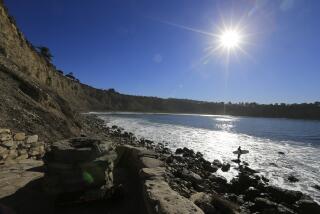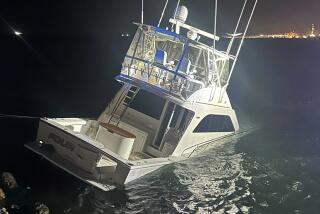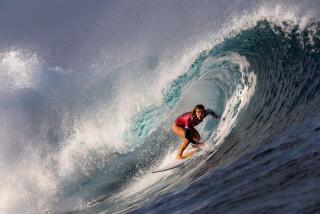The liquid bullring
A lanky cowboy out of the Dakota Badlands, one quarter Lakota Sioux, Hoddy Younger first rode the place in 1937 and never left. It was that kind of wave. He dubbed the spot Tijuana Straits and so it would be known, though principally among those watermen who, in time, would make of its liquid giants the stuff of myth and legend, much like the man who had authored the name.
Younger could have been any boy’s hero, cowboy handsome and cowboy tough. Hoddy could paddle a hundred-pound redwood surfboard a mile out to sea through lines of churning white water, lose it to a wipeout in thirty-foot waves, swim to shore in Mexico, walk back across the invisible line that then separated the two countries, retrieve his board from the beach, paddle back out and do it all over again, in the dead of winter, with nothing to keep him warm but an old-fashioned woolen bathing suit.
FOR THE RECORD: “Tijuana Straits” —In Tuesday’s Outdoors section, an introduction to an excerpt from the surf-noir “Tijuana Straits” said it was Kem Nunn’s third novel in 20 years. He has published five novels; three focus on surfing.
As time passed, he came to ride the waves Island-style, always in trim, always in the fastest part of the wave, at one with the sea. A man of enormous physical power and charisma, he had many admirers but few close friends for he was also a strange and often silent man. If he liked you he would give you the shirt off his back. If he didn’t, he wouldn’t put you out if you were on fire. For Sam the Gull Fahey, in the summer of his fifteenth year, Hoddy Younger did the unthinkable, he showed Fahey the lineups he used to surf the straits. He drew them in the wet sand with a stick — Goat Canyon, Smuggler’s Gulch, Spooner’s Mesa He showed him how to find these landmarks from the water and how to line them up with the old Tijuana lighthouse at the edge of the bullring so that he could wait for the waves in the spots from which he would be able to catch and ride them.
And it was Hoddy who pointed out to him that it was a mistake to call the fourth peak the Mystic Peak. Better, Hoddy said, to simply call it Outside the Bullring because that far out, the lineups didn’t work anymore and one needed to be in tune to other, more subtle hints of seismic activity — like the eerie whistling sounds that seemed at times to emanate from among the great stones washed for a thousand years from the mouth of the river to create the broad alluvial fan that now lay beneath the surface of the sea, to form there the contours and configurations that allowed for the spot’s thick, open ocean waves with their long, peeling shapes.
This, or the sudden disappearance of the Coronado Islands, at which time one would do well to hit the deck of one’s board and paddle for one’s life in the general direction of the Baja Peninsula. In short, Hoddy taught him all he knew, and for a time there it really did seem that he had become the son Hoddy never had, and Hoddy the father of which any boy might have been proud, and in fact Hoddy renamed him as well, for it was Hoddy who dubbed him the Gull.
For many years, Hoddy never owned a house. He lived in a hut made from driftwood and whalebone tucked behind the dunes at the edge of the valley and he taught the Gull about more than the waves. He taught him how to run traps and lobster cages, where the wild squash and tomatoes grew, how to trade with the Mexicans in Tijuana before the coming of the fence. A man could live in the valley then, live off the land and the sea, for Hoddy was more than a surfer. He was a waterman and that, to the mind of young Fahey, was not so much about the practicality as it was about following a path. It was like finding religion, the Gull, his benediction.
Eventually, when the city of Imperial Beach, at that time little more than some vestige of the wild western towns that had once preceded it, decided it needed a lifeguard — which in turn was akin to the town of Tombstone deciding it needed a sheriff — they sent for Hoddy Younger. So that for a while the old surfer moved into a big wooden framed house right down on the sand at the edge of the town and filled it up with aspiring surfers and gave them jobs as lifeguards because Hoddy believed, as the city fathers had believed before him, that any man who could handle himself in the straits could lifeguard for the city and this went for the Gull as well.
Fahey was sixteen at the time, and those were the golden years, the days he went to now in his mind, days of offshore winds and evening glass-offs, of rides so long one’s thighs burned. Then came the first in a series of El Niño winters and with it the waves — one great swell after another, sweeping down from the Gulf of Alaska. In Hawaii, at the All World Wave Masters Surfing Contest, Jason Duane earned fifty thousand dollars and got his picture on the cover of half a dozen surfing magazines.
In California, a stone’s throw from the Mexican border, at the mouth of the Tijuana River, the Gull and Hoddy had ridden waves every bit as awesome, perhaps more so when one took into account the colder water, the longer swim, the absence of helicopters or other emergency vehicles. Yet the feat was witnessed by none save a carload of stoned locals, and even they lost much of it to the fog that had hovered upon the horizon all that day, so that in the end it was the Gull alone, caught inside, awaiting obliteration, who’d seen Younger on what just might have been one of the largest mountains of water ever ridden. It was not much more than a peek, really, for in a moment the very same wave that Hoddy was riding would send him diving for deep water, holding to the eel grass that grew among the stones to save himself from being pulled back up into the maelstrom above — another of Hoddy’s tricks. And afterward there was the swim, rolling sets Christ, he must have made land halfway to Rosarito, then walked home, frozen to the bone Tacos and cerveza from the Mexicans who knew And finally, Hoddy himself, waiting at the border, to shake his hand, for after all, Sam the Gull Fahey had ridden the Mystic Peak. He’d gotten a single wave of his own before Hoddy’s monster had gotten him.
And yet he had glimpsed something more. He had seen his mentor, dwarfed by the mountain he had ridden, the wave face turned to silver in a misty light — a vision by which to steer — and it had seemed to him on that morning, shivering on the beaches of his own home break, there was no end to what he might accomplish.
In the course of the next few winters, he and Hoddy had surfed Outside the Bullring twice more, neither so glorious as the first, yet with none but themselves for company and such were the gleaming paths he trod now in waking dreams, shoveling his earth and worms — one thousand to the pound, sweating out the beer in the noonday sun, hosing down the boxes to keep them wet. On a good day he could find a groove, a crease in time that was neither quite here nor quite there.
On a good day he could still imagine himself on a wave like Hoddy’s. He could still mind surf Outside the Bullring, body English turning his shovel, hips swiveling in the direction of the turn. On bad days, his rhythm was off and the groove eluded him. Money worries and the advance of the years dogged his heels Images of Hoddy in pee-stained khakis, when the city was done with him and the house gone, his beloved beaches lost to pollution, wandering the valley. Or how about the time the staph infection almost took his leg, pumped it up like some African boy with elephantiasis, putting him flat on his back for the better part of a summer — all heat and fever and memories like the living dead? And when it was time to add the pills because the beer wasn’t cutting it.
But he was hoping it wouldn’t come to that, at least not today, what with the first female companionship he’d experienced in more years than he cared to remember watching from the porch as he stacked up the last of the boxes then hosed them down and himself too, then hosed down the windows as well, water pulling rainbows from a blaze of sky, and the feeling came to him that on this particular day, it would all be okay. And when he’d gotten a towel out of the truck and wiped his face with it he went up onto the porch at the side of the trailer and found that she was fast asleep.
More to Read
Sign up for The Wild
We’ll help you find the best places to hike, bike and run, as well as the perfect silent spots for meditation and yoga.
You may occasionally receive promotional content from the Los Angeles Times.










